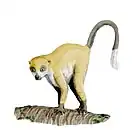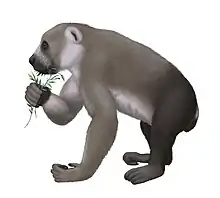| Muangthanhinius Temporal range: Late Eocene | |
|---|---|
| Scientific classification | |
| Domain: | Eukaryota |
| Kingdom: | Animalia |
| Phylum: | Chordata |
| Class: | Mammalia |
| Order: | Primates |
| Suborder: | Strepsirrhini |
| Infraorder: | †Adapiformes |
| Family: | †incertae sedis |
| Genus: | †Muangthanhinius Marivaux et al., 2006 |
| Species: | †M. siami |
| Binomial name | |
| †Muangthanhinius siami Marivaux et al., 2006 | |
Muangthanhinius is a genus of adapiform primate that lived in Asia during the late Eocene.[1][2]
Classification
Muangthanhinius was initially classified as incertae sedis within Adapiformes because Marivaux et al. (2006) noted its distinctness from other named adapiform families. The authors noted its similarity to Bugtilemur, questioning the latter's putative lemuriform affinities. Ni et al. (2016) recovered Muangthanhinius as part of the family Ekgmowechashalidae along with Ekgmowechashala, Bugtilemur, and Gatanthropus.[3]
References
- ↑ L. Marivaux, Y. Chaimanee, P. Tafforeau and J.-J. Jaeger. 2006. New strepsirrhine primate from the late Eocene of peninsular Thailand (Krabi Basin). American Journal of Physical Anthropology 130:425-434
- ↑ Fleagle 2013, p. 243.
- ↑ X. Ni, Q. Li, L. Li and K. C. Beard. 2016. Oligocene primates from China reveal divergence between African and Asian primate evolution. Science 352(6286):673-677.
Literature cited
- Fleagle, J.G. (2013). Primate Adaptation and Evolution (3rd ed.). Academic Press. ISBN 978-0-123-78633-3. OCLC 820107187.
This article is issued from Wikipedia. The text is licensed under Creative Commons - Attribution - Sharealike. Additional terms may apply for the media files.

